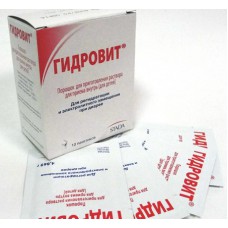Expiration date: 03/2026
The composition and form of issue:
Powder for preparation of solution for the reception inside (for children). 1 packet contains:
sodium chloride 0, 47 g
potassium chloride 0, 3 g
dextrose hydrate 3, 56 g
hydrocitrate sodium 0, 53 g
excipients: silica colloidal anhydrous — 0, 009 g
the total theoretical mass of 4, 869 g
bags of combined material 4, 869 grams in a cardboard bundle 10 bags.
Powder for preparation of solution for the reception inside (for children strawberry). 1 packet contains:
sodium chloride 0, 47 g
potassium chloride 0, 3 g
dextrose hydrate 3, 56 g
hydrocitrate sodium 0, 53 g
excipients: silica colloidal anhydrous — 0, 009 g, aspartame — 0, 06 g of strawberry flavoring Evoglass (H&R 301231) — 0, 07 g of dry spray from roots of sugar beet (N&R 120126) — 0, 08 g, malic acid — 0, 05 g
common theoretical mass — 5, 129 g
bags of combined material in 5, 129 g in cartons of 10 sachets.
Description pharmaceutical form:
Hydrovit (for children): powder white, or almost white.
Hydrovit (for children strawberry): powder light red color, with the smell of strawberries.
Pharmacokinetics:
After oral administration glucose is metabolized to carbon dioxide and water (CO2 and H2O), and the remaining components are excreted primarily in the urine and only small quantities — with sweat or feces.
Description pharmacological action:
A means for intake replacing loss fluids and electrolytes and contributes to the normalization of metabolism and elimination of acidosis.
Hydrovit polyelectrolyte is a drug for oral rehydration. Contains electrolytes, which is often noted with diarrhea in children (Na+, K+, CL-, HCO3-). Timely application of the drug can prevent electrolyte disorders and acidosis, especially in dyspepsia in infants. Part of the preparation glucose is the energy source of providing the basic needs of the body.
Indications:
- As a means of rehydration and electrolyte replacement under the following conditions:
- diarrhea (to compensate for the loss of salts and fluid)
- the heavy sweating during exercise, hyperthermia (to prevent fluid and electrolyte disorders).
Contraindications:
- hyperkalemia
- acute or chronic renal failure
- uncontrollable vomiting
- depression of consciousness, hypovolemic shock
- disturbance of acid-base balance (metabolic alkalosis)
- violation of carbohydrate utilization in the intestine (congenital monosaccharide malabsorption).
- violation of water-electrolyte balance associated with failure of renal function
- heart failure
- hypertension
- diabetes mellitus (Hydrovit contains in a single package 3, 56 g of glucose).
Application of pregnancy and breast-feeding:
The use of the drug is not contraindicated.
Side effects:
In rare cases, nausea and vomiting. Allergic reactions are possible.
Drug interactions:
The effect of cardiac glycosides may be impaired. Patients undergoing treatment with digitalis, when receiving Hydrovit it is necessary to control the concentration of potassium in the blood.
Method of application and dose:
Inside.
The oral solution must be prepared immediately before use according to the following rules:
- Dissolve the contents of one sachet with Hydroviton in 200 ml of drinking or freshly boiled cooled water or tea.
- Immediately drink the solution.
If the child does not drink we offer a portion for the 1st time, the prepared solution is given in small portions, until you reach the recommended dose.
Dosage
Infants and children under 3 years of age — with 3-5 bags (or more, if necessary) within 24 h, equivalent to 1-1, 5 daily dose (prepared solution).
The middle children: single dose of 1 sachet after each bowel movement.
Older children and adults: single dose: 1-2 sachets after each bowel movement.
The drug is administered in the form of a solution at the rate of 150 ml/kg for infants and young children and 20 to 40 ml/kg for children of middle-aged and older adults.
Higher doses can be used at the beginning of treatment for rapid and full compensation of fluid loss.
Duration of treatment: treatment with Hydrovit should continue until the diarrhea lasts.
The appropriateness of continuation of treatment (over 24 h for infants and young children and more than 36 hours for children of school age and adults) is determined by a physician.
At room temperature ready-to-use solution is stable for 1 h. any unused portion of solution should be discarded after 1 h after administration.
If stored in refrigerator, solution is stable more than 24 hours.
Overdose:
Symptoms: for patients without renal impairment, there is generally no risk of poisoning or overdose with this medicine. When using this glucose-electrolyte solution in patients with confirmed or latent flowing diabetes (diabetes mellitus) may increase the blood sugar level up to the state of diabetic coma. Accidental intoxication undiluted powder can disrupt electrolyte balance and increase diarrhea.
You should always consult with a physician in case of overdose.
Special instructions:
Hydroviton treatment should begin as soon as possible to avoid the consequences of serious losses of fluid (depression of consciousness, hypovolemic shock). Severe dehydration, especially in infants, should initially be compensated by intravenous infusion, and then, if appropriate, an oral therapy.
Diarrhoea, followed by frequent vomiting may be a sign of a serious disease. If diarrhea persists for a long time and/or if the General condition worsens, you should immediately consult a doctor.
In applying the drug Hydrovit in children who are breastfed do not require a change in diet. We need to continue to give Hydrovit small portions between feedings.
Children, not breastfeeding, you can go back to normal eating after 6-12 h. infants under 6 months the first portion of milk mixture should be diluted with water (1:2 or 1:1). Infants older their usual serving of formula milk is given undiluted. The younger and older age should be given food containing polymeric carbohydrates that are appropriate to this age (such as potatoes, rice, bananas).
Hydrovit is not recommended, if the administered drug is poorly absorbed in the gastrointestinal tract (e.g. acute intestinal obstruction, vomiting).
Persons suffering from phenylketonuria, a congenital metabolic disorders, it should be remembered that Hydrovit (for children strawberry) contains aspartame — a sugar substitute, which is converted in the body into phenylalanine.
Patients with diabetes should be aware that one package contains Hydrovit 3, 56 g glucose, equivalent to 3, 56 g of carbohydrates, or 0, 3 g sugar carbohydrates.
The glucose concentration in the finished solution for the reception inside: 90 mmol/L.
The concentration of electrolytes in a ready-made solution for the reception inside: Na+ 60 mmol/l K+ 20 mmol/l Cl — 60 mmol/l C6H507- — 10 mmol/L.
The osmolality of the final solution for the reception inside — 240 mOsm/L.
Expiration date:
The prepared solution in a refrigerator for 24 hours at room temperature, 1 h


